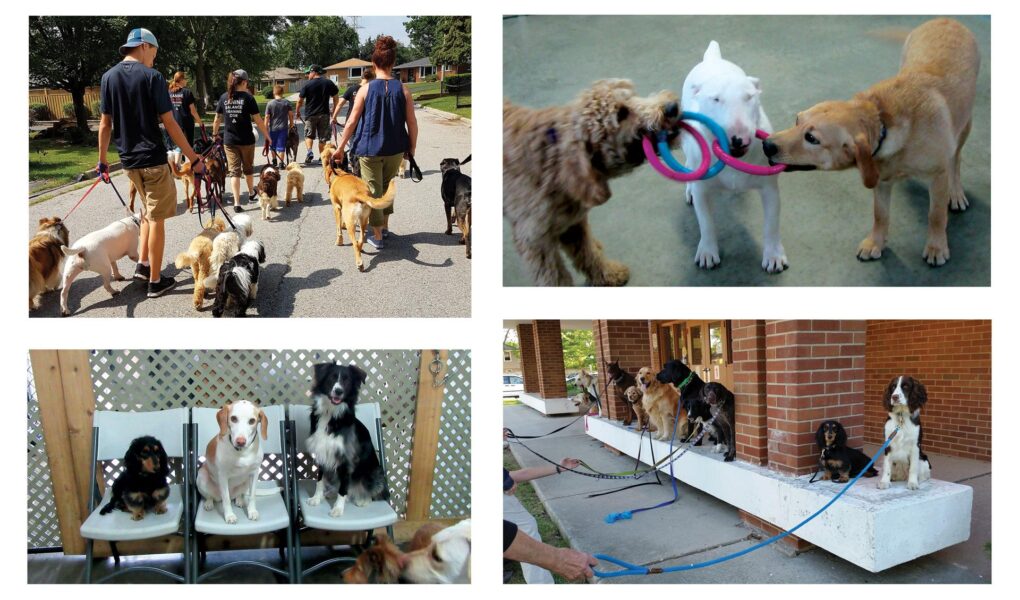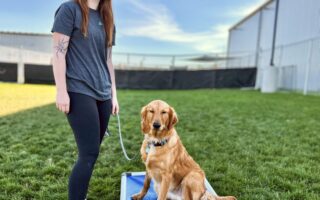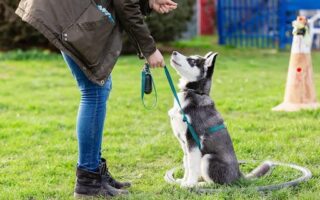Unleashing Stability: The Art of Canine Balance Training
In a world where agility meets precision, the concept of balance training has emerged as a pivotal element in the realm of canine care and development. Just as athletes fine-tune their physical prowess through rigorous training regimens, our four-legged companions too possess an innate need for stability and coordination. Canine balance training encompasses a variety of exercises designed to bolster a dog’s posture, enhance their body awareness, and promote overall physical health. This dynamic approach not only fosters agility and athleticism but also cultivates a deeper bond between dog and owner. In this article, we will explore the fundamentals of canine balance training, its myriad benefits, and practical techniques to embark on an enriching journey toward optimal well-being for our beloved pets.
Table of Contents
- Enhancing Core Stability: The Benefits of Canine Balance Training
- Essential Equipment for Effective Canine Balance Exercises
- Step-by-Step Guide to Implementing Balance Drills at Home
- Monitoring Progress and Adjusting Training for Optimal Results
- Q&A
- Final Thoughts
Enhancing Core Stability: The Benefits of Canine Balance Training
Canine balance training is an innovative approach to enhancing a dog’s core strength, stability, and overall physical confidence. Through targeted exercises, dogs learn to engage their muscles more effectively, promoting better posture and a lower risk of injuries. This type of training focuses on various surfaces and equipment, such as balance discs, wobble boards, and even simple objects like small stairs or logs. By challenging their equilibrium, dogs not only develop stronger core muscles but also improve their body awareness, leading to enhanced performance in other activities like agility, obedience, and daily movements.
The benefits extend beyond the physical realm, touching on mental stimulation and improved communication between the dog and handler. Engaging in balance training provides a fun and interactive way for dogs to bond with their owners while building trust and understanding. Here are some key advantages of incorporating balance training into your dog’s routine:
- Improved Coordination: Helps dogs navigate various terrains with agility.
- Enhanced Fitness: Increases muscle tone and endurance.
- Better Focus: Encourages dogs to pay attention and follow commands.
- Injury Prevention: Strengthens muscles and joints, reducing vulnerability.
Essential Equipment for Effective Canine Balance Exercises
To embark on a successful journey into canine balance training, it’s crucial to equip yourself with the right tools. Balance discs, fit balls, and wobble boards form the cornerstone of any effective training regimen. These pieces of equipment challenge your dog’s stability, engaging their core muscles and enhancing their proprioception. Additionally, cavalettis or jump poles can also be incorporated to improve coordination while making the exercise enjoyable. Ensure you have a safe space where you can introduce these tools gradually, ensuring your furry companion feels comfortable and confident amidst new challenges.
Incorporating a variety of equipment not only keeps your dog engaged but also produces well-rounded developmental benefits. Here’s a quick reference table for some essential gear:
| Equipment | Purpose | Benefits |
|---|---|---|
| Balance Discs | Challenge stability | Strengthens core muscles |
| Wobble Boards | Improve coordination | Enhances proprioceptive awareness |
| Cavalettis | Footwork training | Improves agility |
| Fit Balls | Dynamic balance | Increases core strength |
Having the right accessories can make balance training both effective and enjoyable. Consider adding treats and toys to motivate your dog during exercises. Rewards play a significant role in maintaining their interest, ultimately leading to successful outcomes. Consistency and positive reinforcement are integral to your training approach, allowing for a fun bonding experience while cultivating essential skills.
Step-by-Step Guide to Implementing Balance Drills at Home
To begin with, select a safe and spacious area in your home or yard for balance training. Make sure the surface is even and free from obstacles. Start with simple body awareness exercises, such as having your dog stand on different surfaces or objects like a balance disc or a sturdy board. Gradually introduce low-height platforms, ensuring they are secure. This helps your dog build confidence and stability while encouraging natural curiosity. You can also incorporate everyday household items as props, such as cushions or small boxes, to create a makeshift obstacle course.
Next, focus on incremental challenges to enhance your canine’s balancing skills. Utilize treats and positive reinforcement to motivate your dog. To create a pathway, use an array of equipment or items placed in sequence that your dog can navigate through, varying the heights and widths. Here are some exercises to include:
- Walking on a straight line of books or logs
- Leaping from one soft surface to another
- Rolling a large ball for them to balance on with their front paws
Monitor their progress and celebrate successes, no matter how small, to foster a positive training environment. Keep sessions short—around 10 to 15 minutes—to maintain focus and enjoyment for your dog.
Monitoring Progress and Adjusting Training for Optimal Results
To achieve optimal results in canine balance training, it’s essential to regularly monitor your dog’s progress. Start by establishing baseline metrics, such as the duration your dog can maintain balance on an unstable surface or the number of successful attempts during a training session. Use these metrics to create a progress chart that visually tracks improvements over time. Remember to observe not just the achievements but also your dog’s attitude and enthusiasm during sessions. If your canine companion seems frustrated or disinterested, it may be time to adjust the training methods or the exercises being used.
As your dog develops their balance skills, consider the following strategies to enhance their training:
- Incremental Difficulty: Gradually increase the complexity of exercises by introducing new equipment, such as wobble boards or balance discs.
- Positive Reinforcement: Reward your dog with treats and praise for each milestone, reinforcing their motivation to engage with the training.
- Routine Assessment: Schedule regular assessments every few weeks to evaluate progress and reset goals based on your dog’s current skill level.
| Progress Metrics | Week 1 | Week 2 | Week 3 |
|---|---|---|---|
| Duration on Wobble Board | 10 seconds | 20 seconds | 30 seconds |
| Successful Attempts (out of 10) | 4 | 6 | 8 |
| Confidence Level (1-5) | 2 | 3 | 4 |
Q&A
Q&A: Exploring Canine Balance Training
Q1: What exactly is canine balance training?
A1: Canine balance training is a specialized form of exercise that focuses on improving a dog’s core strength, stability, and coordination. By using various equipment and techniques, this training helps dogs learn how to maintain their balance in different situations, which can enhance their overall physical fitness and agility.
Q2: Why is balance important for dogs?
A2: Just like humans, dogs rely on balance for a myriad of everyday activities, from playing fetch to navigating tricky terrain. Improved balance can help prevent injuries during high-energy activities and promote better body awareness, making it easier for them to execute movements with grace and confidence.
Q3: What are some common exercises used in canine balance training?
A3: A variety of exercises can be used in balance training, including using balance discs, wobble boards, and foam cushions. Simple activities might involve having a dog stand on an unstable surface, walk along narrow paths, or perform specific commands that require shifting their weight and maintaining stability.
Q4: At what age should balance training start for a dog?
A4: Balance training can be beneficial for dogs of all ages, but it’s best to introduce it gradually. Puppies can begin with simple activities once they have completed their vaccinations, while older dogs or those with existing health concerns should consult a veterinarian before starting a new training regimen.
Q5: Are there specific breeds that benefit more from balance training?
A5: While all dogs can benefit from balance training, certain breeds that participate in agility sports or activities that require strength and coordination, such as Border Collies and Belgian Malinois, may see notable improvements. However, balance training can be tailored to meet the needs of any breed, enhancing physical capabilities across the board.
Q6: How can I tell if my dog enjoys balance training?
A6: A dog that enjoys balance training will typically display enthusiasm during exercises, such as wagging their tail, exhibiting eagerness to learn, and engaging actively. If they seem reluctant or stressed, it might indicate that the exercises are too challenging, or they aren’t enjoying the activity; adjusting the routine is key!
Q7: Can balance training help with behavioral issues?
A7: Yes, balance training can contribute positively to behavioral management. Exercises that require focus and concentration can help alleviate issues such as hyperactivity or anxiety. Additionally, the bond created during training sessions fosters trust and cooperation, which are essential for good behavior.
Q8: What equipment do I need to get started with balance training?
A8: Essential equipment for canine balance training includes balance pads, wobble boards, and stability discs. You can also incorporate everyday items such as cones or low obstacles to increase variability in the training sessions. Always ensure that any equipment is safe and appropriate for your dog’s size and strength.
Q9: How often should I train my dog in balance exercises?
A9: Consistency is key, and it’s generally recommended to engage in balance training a few times a week for 10 to 15 minutes per session. This allows for gradual improvements without overwhelming your dog, while also making training enjoyable.
Q10: Where can I learn more about canine balance training?
A10: To delve deeper into canine balance training, consider attending workshops, consulting with a professional dog trainer, or exploring online resources such as videos and articles. Many communities also offer classes, providing an excellent opportunity to engage with other dog owners and learn together.
Final Thoughts
As we conclude our exploration of canine balance training, it becomes clear that this practice is more than just a physical exercise; it is a bridge that connects the mind and body of our furry friends. Through the artful integration of core strength, coordination, and confidence-building, balance training unlocks new dimensions of fitness and well-being for dogs of all ages and abilities.
By incorporating these techniques into your pet’s routine, you not only enhance their physical prowess but also deepen the bond you share, transforming playtime into a rewarding experience for both of you. So, whether you’re guiding your pup through wobble boards or introducing them to the challenge of balance discs, remember that each small step contributes to a healthier, happier dog.
As you embark on this journey into the world of canine balance training, may you find joy in the process and pride in the progress. Happy training!



